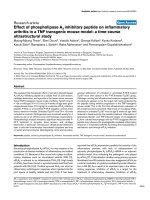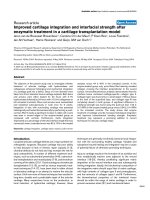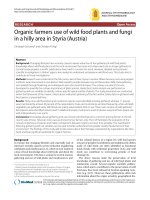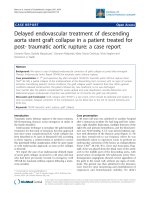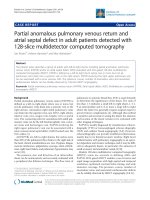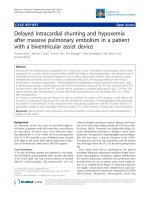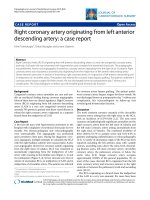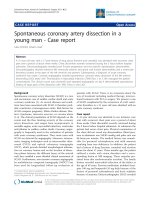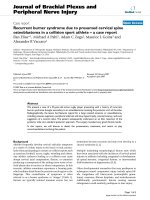Báo cáo y học: " Spontaneous coronary artery dissection presenting as an ischaemic stroke in a middle-aged man with anti-cardiolipin antibodies: a case report" ppsx
Bạn đang xem bản rút gọn của tài liệu. Xem và tải ngay bản đầy đủ của tài liệu tại đây (1.61 MB, 4 trang )
CAS E REP O R T Open Access
Spontaneous coronary artery dissection
presenting as an ischaemic stroke in a
middle-aged man with anti-cardiolipin antibodies:
a case report
NS Rajendra
*
, F Lim, N Shaukat
Abstract
Introduction: Cerebrovascular disease is a major cause of mortality and morbidity worldwide. Ischemic stroke is
the most common manifestation, encompassing a wide variety of causative mechanisms. We present the case of a
middle-aged male patient with spontaneous coronary artery dissection in the presence of anti-cardiolipin
antibodies, leading to left ventricular thrombus and presenting with stroke.
Case presentation: A 56-year-old Caucasian man presented with dysarthria and right-sided weakness. There was a
history of chest pain with autonomic symptoms four days earlier. Examination revealed right-sided hemiparesis.
Electrocardiogram showed sinus rhythm with anterior Q wav es. Magnetic resonance imaging of the brain showed
large left parietal and smaller multiple cerebral infarcts. Echocardiogram showed anterior wall and apical akinesis
with a large mural thrombus. Anti-cardiolipin antibodies immunoglobulin G and immunoglobulin M were strongly
positive. Coronary angiography showed dissection of the mid left anterior descending artery with normal flow
down the distal vessel. He was treated conservatively with anticoagulation and secondary prevention. He was in
good health when seen in clinic four months later.
Conclusion: We highlight the importance of a comprehensive approach at obtaining the correct diagnosis, input
of different specialities and the fact that the presence of anti-cardiolipin antibodies is associated with coronary
artery dissection in a middle-aged male patient whose presentation was strok e.
Introduction
Spontaneous coronary artery dissection (SCAD) is well
described in women, especially pregnant women. We
present the case of a man with SCAD which was com-
plicated by stroke due to a left ventricular thrombus.
Case presentation
A 56-year-old, Caucasian man presented with dy sarthri a
and right-sided weakness to a district general hospital.
There was a history of chest pain associated with sweat-
ing, nausea and vomiting four days earlier for which he
had not sought medical help. He also had a history of
lower limb deep vein thrombosis (DVT) four years ago.
He was not taking any medications currently, and apart
from his age there were no other cardiovascular risk
factors.
Examination revealed right-sided weakness but noth-
ing else of note. Electrocardiogram (ECG) showed sinus
rhythm with anterior Q waves and MRI scan of the
head showed a large left parietal lobe infarct and multi-
ple smaller cerebral infarcts (Figure 1). An echocardio-
gram showed anterior wall and apical akinesis with a
large left ventricular mural thrombus (Figure 2). Carotid
Doppler measurements were all normal and blood tests
revealed strongly positive anti-cardiolipin antibodies.
Due to our patient’s regional wall motion abnormal-
ities, ECG changes and history, a coronary angiography
was performed which showed a healed dis section of the
mid left anterior descending artery with thrombolysis in
myocardial infarction grade 3 (TIMI-3) flow down the
* Correspondence:
Department of Cardiology, Kettering General Hospital, Rothwell Road,
Kettering NN16 8UZ, UK
Rajendra et al. Journal of Medical Case Reports 2010, 4:94
/>JOURNAL OF MEDICAL
CASE REPORTS
© 2010 Rajendra et al; licensee BioMed Central Ltd. This is an Open Access article distribu ted under the terms of the Creative
Commons Attribu tion License ( .0), which permits unrestricted use, distribution, and
reproduction in any medium, provided the original work is properly cited.
Figure 1 MRI of brain showing a large left parietal and multiple smaller cerebral infarcts.
Figure 2 Two-dimensional echo-4 chamber view showing left ventricular apical thrombus.
Rajendra et al. Journal of Medical Case Reports 2010, 4:94
/>Page 2 of 4
distal vessel (Figure 3). The rest of the coronary arteries
were all normal.
In view of the above, a diagnosis of SCAD in association
with anti-cardiolipin antibodies was made. SCAD had
resulted in myocardial infarction leading to the develop-
ment of a left ventricular thrombus which had embolized
causing a stroke, which was his presenting complaint. The
patient was anticoagulated with warfarin and secondary
prevention instituted with angiotensin-converting enzyme
(ACE) inhibitor, statin and beta-blocker. Due to a past his-
tory of DVT, it was decided that he should continue taking
warfarin for life. When reviewed in clinic four months
later he had made an excellent neurological recovery and
had no new symptoms. A repeat coronary angiogram
10 months after his initial presentation showed no new or
progressive changes.
Discussion
Spontaneous coronary artery dissection is a rare but
potentially fatal condition, described mainly in young
women, especially in the peripartum period [1]. Other
associations of SCAD described in the literature are oral
contraceptive use [2], antiphospholipid syndrome (APS)
[3,4], connectiv e tissue disorder [5], cocaine use [6] and
physical exertion [7].
Antiphospholipid syndrome is characterized by the
presence of antipho spholipid antibodies. The pathogno-
monic feature of this condition is recurrent thrombosis
in both the arterial and venous circulations, and the
possible causative mechanisms have been reviewed
recently [8]. With particular reference to SCAD, recent
evidence suggests a widespread endothelial dysfunction
in APS [9]. Coronary endothelial dysfunction could
therefore play a major role in the pathogenesis of SCAD
along with other factors such as plaque or vasa vasorum
rupture, localized vasculitis with eosinophilic infiltration,
and increased shear stress. The preponderance of SCAD
in pregnancy is also thought to be due to the high circu-
lating levels of oestrogen and progesterone. Therefore a
high degree of suspicion about APS and SCAD is neces-
sary when dealing with pregnant o r young women pre-
senting w ith chest pains and ECG changes. While
strokes secondary to SCAD are reported [10,11], albeit
extremely rarely and in younger subjects, they have not
been reported, to the best of our knowledge, in a mi-
ddle-aged man in a ssociation with anti -cardiolipin
antibodies.
Treatment of SCAD, although lacking in consensus,
depends on the clinical sit uation. If the patient i s
asymptomatic and stable, con servative management is
advised, as in the case of o ur patient. Successful revas-
cularization in acutely unwell patients, in the form of
percutaneous coronary intervention [12] and coronary
artery bypass grafting [13] have been described in the
literature. Thrombolysis can be devastating if adminis-
tered in the presence of S CAD [14,15]. The cornerst one
of treatment to prevent recurrent thrombosis is
anticoagulation.
Figure 3 Coronary angiography. Posteroanterior cranial view showing contained dissection of mid left anterior descending artery (LAD).
Rajendra et al. Journal of Medical Case Reports 2010, 4:94
/>Page 3 of 4
Conclusion
Although carotid artery disease is the major culprit in
ischemic strokes, it is important to exclude an embolic
phenomenon in younger patients. Left ventricular
thrombus is one o f the potential embo lic causes. Our
patient’s stroke was due to embolization from a ventri-
cular thrombus which was in turn caused by a coronary
artery dissection in the presence of anti-cardiolipin anti-
bodies, an association rarely described in middle-aged
men. It is therefore important to have a comprehensive
approach to diagnosis and evidence-based management
in such patients, which in turn highlights the impor-
tance of multi-disciplinary teams working together.
Consent
Written informed consent was obtained from the patient
for publication of this case report and accompanying
images. A copy of the written consent is available for
review by the Editor-in-Chief of this journal.
Authors’ contributions
NSR is the principal author who performed the literature search and drafted
the case report, FL helped in literature search and NS is the consultant in
charge of the patient’s clinical care. NS also refined the manuscript. All
authors have read and approved the final manuscript.
Competing interests
The authors declare that they have no competing interests.
Received: 18 September 2009 Accepted: 24 March 2010
Published: 24 March 2010
References
1. Kamineni R, Sadhu A, Alpert JS: Spontaneous coronary artery dissection:
report of two cases and a 50-year review of the literature. Cardiol Rev
2002, 10:279-284.
2. Evangelou D, Letsas KP, Korantzopoulos P, Antonellis I, Sioras E, Kardaras F:
Spontaneous coronary artery dissection associated with oral
contraceptive use: A case report and review of the literature. Int J Cardiol
2006, 112:380-382.
3. Krishnamurthy M, Desai R, Patel H: Spontaneous coronary artery
dissection in the postpartum period: association with antiphospholipid
antibody. Heart 2004, 90:e53.
4. Reed RK, Malaiapan Y, Meredith IT: Spontaneous Coronary artery
dissection in a female with antiphospholipid syndrome. Heart Lung Circ
2007, 16:120-122.
5. Sharma AK, Farb A, Maniar P, Ajani AE, Castagna M, Virmani R, Suddath W,
Lindsay J: Spontaneous coronary artery dissection in a patient with
systemic lupus erythematosis. Hawaii Med J 2003, 62:248-253.
6. Steinhauer JR, Caulfield JB: Spontaneous coronary artery dissection
associated with cocaine use: A case report and brief review. Cardiovasc
Pathol 2001, 10:141-145.
7. Ellis CJ, Haywood GA, Monro JL: Spontaneous coronary artery dissection
in a young woman resulting from an intense gymnasium “work-out”. Int
J Cardiol 1994, 47:193-194.
8. Vega-Ostertag ME, Pierangeli SS: Mechanisms of aPL-mediated
thrombosis: effects of aPL on endothelium and platelets. Curr Rheumatol
Rep 2007, 9:190-197.
9. Alexanderson E, Cruz P, Vargas A, Meave A, Ricalde A, Talayero JA, Romero-
Ibarra JL, Goldson TM, Vera-Lastra OL, Medina G, Jara L, Amigo MC:
Endothelial dysfunction in patients with antiphospholipid syndrome
assessed with positron emission tomography. J Nucl Cardiol 2007,
14:566-572.
10. Jaigobin C, Silver FL: Stroke secondary to post-partum coronary artery
dissection. Can J Neurol Sci 2003, 30(2):193-194.
11. Marriott E, Schneck MJ, Barron JT, Cho L, Biller J: Left ventricular thrombus
discovered on chest computed tomography for presumed cryptogenic
stroke. J Stroke Cerebrovasc Dis 2006, 15(1):41-42.
12. Le MQ, Ling FS: Spontaneous dissection of the left main coronary artery
treated with percutaneous coronary stenting. J Invasive Cardiol 2007, 19:
E218-221.
13. Thistlethwaite PA, Tarazi RY, Giordano FJ, Jamieson SW: Surgical
management of spontaneous left main coronary artery dissection. Ann
Thorac Surg 1998, 66:258-260.
14. Buys EM, Suttorp MJ, Morshuis WJ, Plokker HW:
Extension of a
spontaneous coronary artery dissection due to thrombolytic therapy.
Cathet Cardiovasc Diagn 1994, 33:157-160.
15. Zupan I, Noc M, Trinkaus D, Popovic M: Double vessel extension of
spontaneous left main coronary artery dissection in young women
treated with thrombolytics. Catheter Cardiovasc Interv 2001, 52:226-230.
doi:10.1186/1752-1947-4-94
Cite this article as: Rajendra et al.: Spontaneous coronary artery
dissection presenting as an ischaemic stroke in a middle-aged man
with anti-cardiolipin antibodies: a case report. Journal of Medical Case
Reports 2010 4:94.
Submit your next manuscript to BioMed Central
and take full advantage of:
• Convenient online submission
• Thorough peer review
• No space constraints or color figure charges
• Immediate publication on acceptance
• Inclusion in PubMed, CAS, Scopus and Google Scholar
• Research which is freely available for redistribution
Submit your manuscript at
www.biomedcentral.com/submit
Rajendra et al. Journal of Medical Case Reports 2010, 4:94
/>Page 4 of 4
